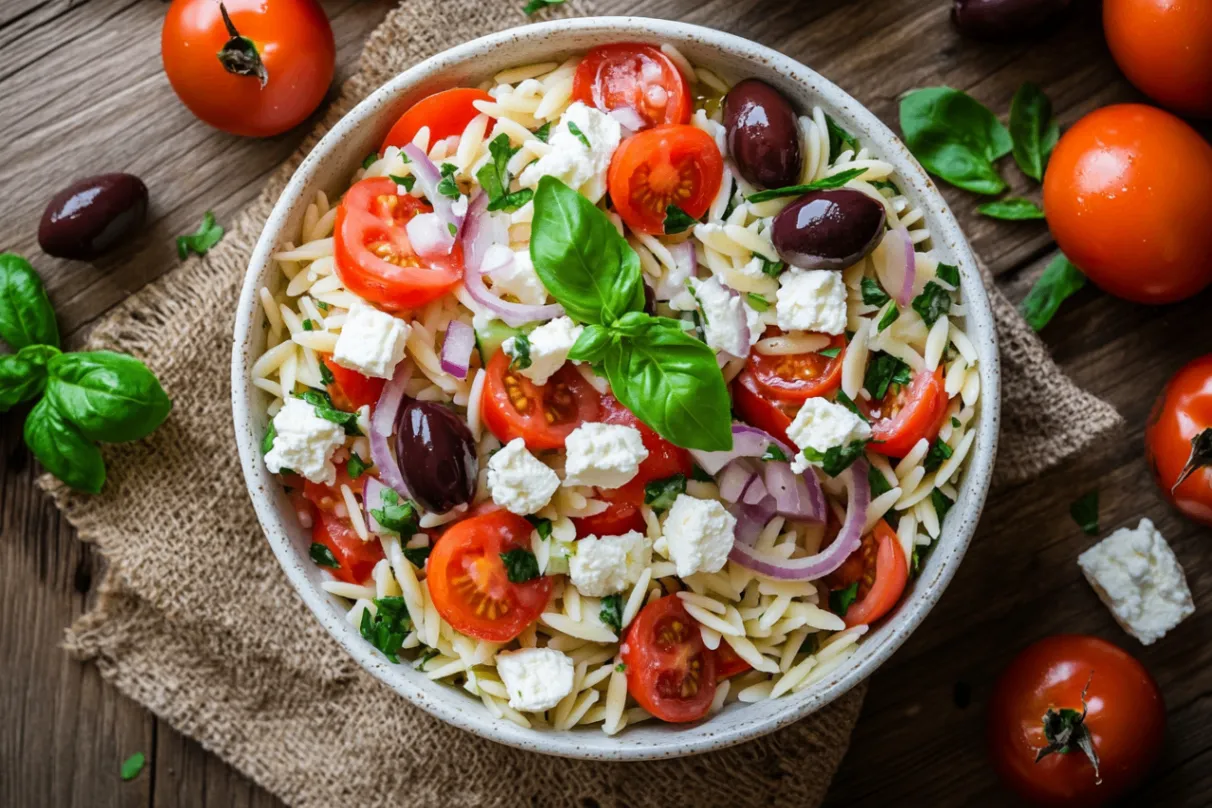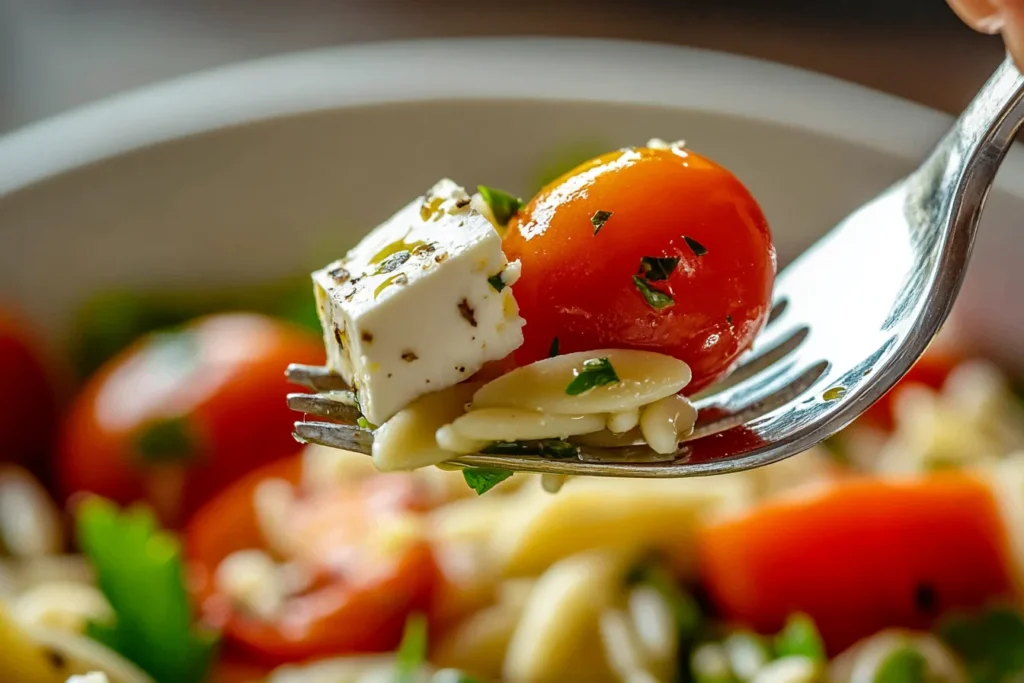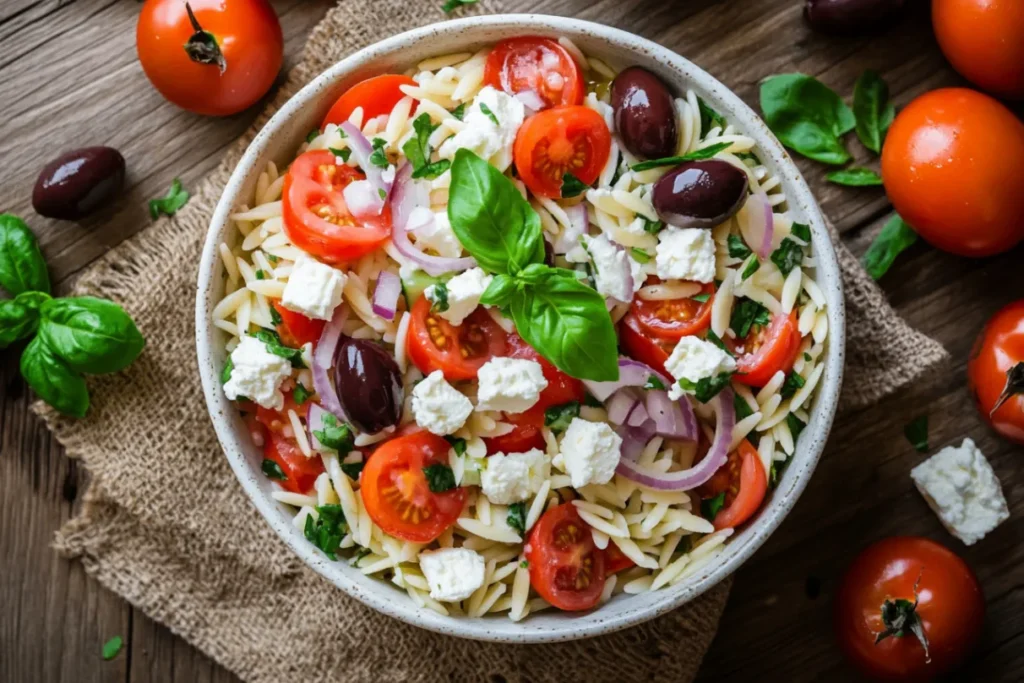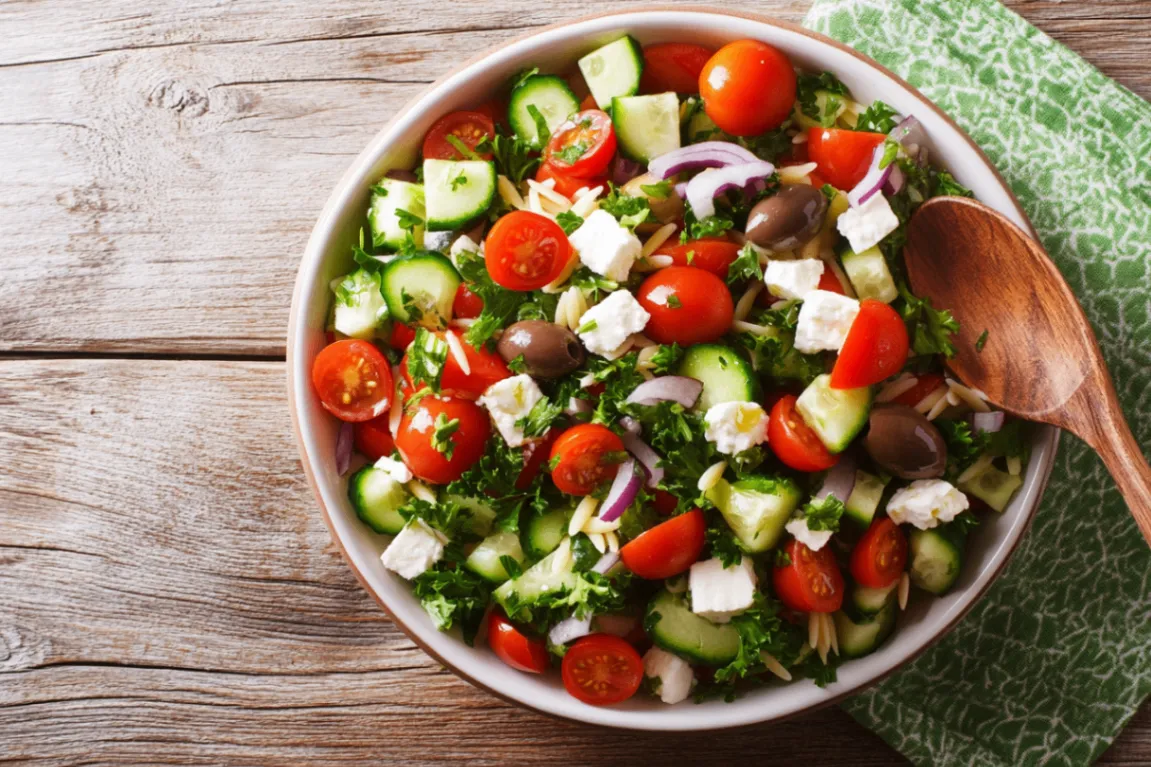Table of Contents
Table of Contents
There’s something magical about a dish that transports you straight to the sun-soaked islands of Greece with just one bite. Greek Orzo Salad has become one of my absolute favorite go-to recipes, and I’m thrilled to share it with you today. This vibrant, flavor-packed salad first captured my heart during a family gathering last summer when my Greek neighbor, Maria, brought over a massive bowl that disappeared within minutes. The combination of tender orzo pasta, creamy feta cheese, and fresh Mediterranean vegetables creates a symphony of flavors that’s both satisfying and refreshing.
What makes this Greek Orzo Salad truly special is its versatility – it works beautifully as a light lunch, a side dish for grilled meats, or even as the star of your next potluck. The recipe has quickly become a staple in my kitchen, especially during those busy weekdays when I need something nutritious, delicious, and incredibly easy to prepare. Trust me, once you try this Mediterranean masterpiece, you’ll understand why it’s earned a permanent spot in my collection of family favorite recipes.

Greek Orzo Salad With Fet
Ingredients
Nutrition
Tried this recipe?
Let us know how it was!The Heart of Greek Orzo Salad: Essential Ingredients
Understanding the Star Players and Their Mediterranean Magic
The beauty of Greek Orzo Salad lies in its carefully chosen ingredients, each playing a crucial role in creating that authentic Mediterranean flavor profile. At the center of our dish is orzo pasta – those tiny, rice-shaped gems that perfectly absorb all the wonderful flavors we’ll be adding. Unlike traditional pasta salads that can feel heavy, orzo provides the ideal texture that’s both satisfying and light.
Feta cheese serves as our creamy, tangy cornerstone, bringing that distinctive Greek character that makes this salad unforgettable. The saltiness of quality feta balances beautifully with the bright acidity of fresh lemon juice and the richness of extra virgin olive oil. Cherry tomatoes add bursts of sweetness and vibrant color, while Kalamata olives contribute their deep, briny complexity that’s absolutely essential to authentic Greek cuisine.
Fresh herbs – particularly oregano, parsley, and sometimes dill – elevate this Greek Orzo Salad from good to extraordinary. These aromatics don’t just add flavor; they bring that fresh, garden-like quality that makes every bite feel like a Mediterranean vacation. Red onions provide a sharp contrast and beautiful color, while cucumbers add refreshing crunch that keeps the salad interesting with every forkful.
Selecting Premium Ingredients for Maximum Flavor Impact
When creating the perfect Greek Orzo Salad, ingredient quality makes all the difference between a good dish and an unforgettable one. For orzo pasta, I always recommend choosing a high-quality brand – look for pasta made with durum wheat semolina, as it holds its shape better and has a more satisfying bite. The pasta should feel firm and have a slightly rough texture that helps the dressing cling beautifully.
Selecting the right feta cheese is crucial for authentic flavor. Avoid pre-crumbled feta if possible, as it often lacks the creamy texture and robust taste of block feta. Look for feta packed in brine – this keeps it moist and flavorful. Greek or Bulgarian feta tends to have the most authentic taste, with a perfect balance of saltiness and creaminess that makes this easy homemade recipe truly shine.
For vegetables, choose the ripest, most colorful produce you can find. Cherry tomatoes should be firm but give slightly to gentle pressure, indicating perfect ripeness. Kalamata olives are worth seeking out over generic black olives – their complex, wine-like flavor is irreplaceable in traditional Greek cooking. When selecting red onions, choose ones that feel heavy for their size with tight, papery skins, and always store them properly to maintain their sharp, clean flavor.
Smart Substitutions and Creative Alternatives
While I always encourage sticking to traditional ingredients for the most authentic Greek Orzo Salad experience, I understand that sometimes substitutions are necessary. If orzo isn’t available, small shell pasta, ditalini, or even couscous can work as alternatives, though each will create a slightly different texture and eating experience.
For those who can’t find or don’t enjoy feta cheese, there are several delicious alternatives. Goat cheese provides a similar tangy creaminess, while ricotta salata offers a comparable texture with milder flavor. Vegan alternatives include cashew-based feta substitutes or simply increasing the olive oil and lemon juice for extra richness and flavor in your delicious dish.
Vegetable substitutions can add interesting twists to your Greek Orzo Salad while maintaining its Mediterranean character. Sun-dried tomatoes can replace or complement fresh tomatoes for intense flavor, while roasted red peppers add sweetness and smoky depth. If Kalamata olives aren’t available, green olives or even capers can provide the necessary briny element, though the flavor profile will shift slightly. Fresh herbs are quite flexible – basil, mint, or even cilantro can create interesting variations while keeping the salad fresh and aromatic.

Mastering the Art of Greek Orzo Salad Preparation
Essential Prep Work and Kitchen Organization Tips
Creating the perfect Greek Orzo Salad starts long before you turn on the stove, and proper preparation is the secret to a stress-free cooking experience. Begin by gathering all your ingredients and measuring everything out – this French technique called “mise en place” ensures smooth sailing once you start cooking. Fill a large pot with water and set it on the stove to boil; orzo cooks quickly, but getting that water to boil takes the longest time in this recipe.
While waiting for the water, focus on preparing your vegetables. Wash your cherry tomatoes and pat them completely dry – excess water will dilute your dressing and make the salad watery. If you’re using larger tomatoes instead of cherry varieties, remove the seeds to prevent excess moisture. Cut your red onion into thin, uniform slices, then soak them in cold water for 10-15 minutes to mellow their bite – this small step makes a huge difference in the final flavor balance of your Greek Orzo Salad.
Prepare your feta by removing it from the brine and gently patting it dry with paper towels. If using block feta, cut it into bite-sized cubes rather than crumbling it with your hands – this helps maintain better texture and prevents the cheese from becoming too powdery. Have your herbs washed, dried, and roughly chopped, and measure out your olive oil and lemon juice. This organized approach transforms what could be a chaotic cooking session into a smooth, enjoyable process.
Step-by-Step Cooking Instructions with Professional Secrets
Now comes the exciting part – bringing your Greek Orzo Salad to life! Once your water reaches a rolling boil, add a generous amount of salt (the water should taste like the sea), then add your orzo pasta. Here’s my secret: cook the orzo for exactly one minute less than the package directions suggest. This slight undercooking prevents the pasta from becoming mushy when mixed with the dressing and ensures perfect texture in your finished salad.
While the orzo cooks, prepare your dressing by whisking together extra virgin olive oil, fresh lemon juice, minced garlic, dried oregano, salt, and freshly ground black pepper. The ratio I’ve perfected over years of making this family favorite recipe is roughly 3:1 oil to lemon juice, but taste and adjust according to your preferences. The dressing should be bright and assertive – remember, it needs to flavor a good amount of pasta and vegetables.
Here’s the game-changing technique that separates good Greek Orzo Salad from extraordinary: immediately after draining the hot orzo, toss it with about half of your prepared dressing while it’s still warm. This allows the pasta to absorb the flavors deeply, creating much more complex taste than simply mixing everything cold. Let the dressed orzo cool to room temperature before adding the remaining ingredients – this prevents the vegetables from wilting and maintains the fresh, crisp textures that make this delicious dish so appealing.
Avoiding Common Pitfalls and Professional Problem-Solving
Even experienced cooks can encounter challenges when making Greek Orzo Salad, but knowing what to watch for prevents most issues before they start. The most common mistake is overcooking the orzo pasta, which leads to mushy, unappetizing texture. Remember that pasta continues cooking slightly even after draining, so that one-minute undercook I mentioned earlier is crucial for perfect results.
Another frequent problem is watery salad caused by wet vegetables or insufficient draining of ingredients. Always pat tomatoes and cucumbers dry after washing, and if your feta seems particularly moist, let it drain on paper towels for a few minutes. When draining olives, give them time to shed excess brine – those few extra minutes of patience result in much better flavor balance in your finished easy homemade recipe.
Temperature timing can also trip up home cooks. Adding cold vegetables to hot pasta can create condensation, leading to watery dressing, while adding hot dressing to cold vegetables can wilt delicate ingredients. The key is bringing everything to room temperature before final assembly. If you’re making this Greek Orzo Salad ahead of time, remember that flavors meld and develop, so you might need to adjust seasoning before serving. A squeeze of fresh lemon juice and a pinch of salt often bring everything back into perfect balance.

Serving Perfection: Presentation and Pairing Ideas
Creative Presentation Techniques That Wow Every Time
The visual appeal of your Greek Orzo Salad can elevate it from a simple side dish to the stunning centerpiece of your table. Start with your serving vessel – a large, shallow bowl allows guests to see all the beautiful colors and textures, while a clear glass bowl showcases the vibrant ingredients like a edible rainbow. For individual servings, consider using small Mediterranean-style bowls or even hollowed-out bell peppers for a creative, Instagram-worthy presentation.
Garnishing your Greek Orzo Salad thoughtfully adds both visual appeal and extra flavor layers. Reserve some of your most beautiful cherry tomatoes, perfect olive halves, and largest feta cubes for the top of the salad. A sprinkle of fresh herbs just before serving adds color and aroma that makes mouths water before the first bite. For special occasions, consider adding a few fresh flowers like nasturtiums or herb blossoms – they’re edible and create an absolutely stunning presentation that guests will remember long after the meal ends.
Color contrast and height variation make your delicious dish more visually interesting. Scatter ingredients rather than mixing them uniformly, creating natural-looking clusters of tomatoes, olives, and feta throughout the salad. A light drizzle of your best olive oil just before serving adds appealing sheen and fresh flavor. For buffet-style serving, provide both a large spoon and tongs – this gives guests options and prevents the beautiful presentation from being destroyed by the first person served.
Perfect Pairing Partners for Every Occasion
Greek Orzo Salad shines as both a standalone meal and a supporting player alongside other dishes, making it incredibly versatile for menu planning. For casual weeknight dinners, pair it with simple grilled chicken, lamb, or fish – the bright, acidic flavors in the salad provide perfect contrast to rich proteins. The Mediterranean flavor profile makes it a natural companion to other Greek dishes like moussaka, souvlaki, or spanakopita for themed dinner parties.
During summer entertaining, this family favorite recipe works beautifully alongside grilled vegetables, fresh bread, and other cold salads for a varied, satisfying spread. Consider serving it with warm pita bread, hummus, and tzatziki for a complete Mediterranean mezze experience. The salad’s refreshing qualities make it an excellent palate cleanser between heavier courses, while its substantial nature means it can easily serve as a light lunch with some crusty bread and perhaps a glass of crisp white wine.
For potluck gatherings and picnics, Greek Orzo Salad is a crowd-pleaser that travels well and actually improves in flavor as it sits. Pack it in a large, attractive serving bowl with serving utensils, and consider bringing some extra feta cheese and fresh herbs for last-minute garnishing. The salad pairs wonderfully with barbecue dishes, providing a fresh, cooling contrast to smoky, grilled flavors that everyone appreciates during outdoor gatherings.
Storage Wisdom and Reheating Best Practices
Proper storage techniques ensure your Greek Orzo Salad maintains its delicious flavor and appealing texture for several days after preparation. Transfer any leftovers to an airtight container and refrigerate promptly – the salad will keep beautifully for up to four days when stored properly. The flavors actually develop and deepen over time, making day-two salad often even more delicious than when freshly made.
Before serving leftover Greek Orzo Salad, always give it a good stir and taste for seasoning adjustments. The pasta and vegetables absorb the dressing over time, so you might need to add a splash of fresh lemon juice, a drizzle of olive oil, or a pinch of salt to brighten the flavors. Fresh herbs lose their vibrancy quickly, so consider adding a handful of freshly chopped parsley or oregano to revive the salad’s fresh, garden-like quality.
While this easy homemade recipe is typically served cold or at room temperature, some people enjoy it slightly warmed. If you prefer warm orzo salad, remove it from the refrigerator about 30 minutes before serving to take the chill off, or very gently warm it in the microwave for 20-30 seconds, stirring carefully to avoid overheating the delicate vegetables. Never reheat the salad to steaming hot, as this will wilt the vegetables and alter the intended texture and flavor balance that makes this delicious dish so special.
 DINNER
DINNER  LUNCH
LUNCH  Desserts
Desserts  BREAKFAST
BREAKFAST For more amazing recipes, be sure to check out our other sections to explore a variety of ideas that will enrich your cooking experience. Each section offers its own unique flavors to ensure a delightful culinary journey:
Easy and Quick Recipes: A collection of dishes that guarantee delicious meals with minimal effort and time.
Healthy Recipes: Discover healthy and delicious options that fit your lifestyle.
Desserts: A diverse selection of sweets that will add a special touch of sweetness to your table.
Lunch Recipes: Tasty lunch ideas that you can easily prepare to delight your family.
Dinner Recipes: Delicious and easy-to-make recipes that will make your dinner a memorable occasion.

Frequently Asked Questions About Greek Orzo Salad
Q: How far in advance can I make Greek Orzo Salad? A: Greek Orzo Salad actually improves when made ahead! You can prepare it up to 24 hours in advance, storing it covered in the refrigerator. The flavors meld beautifully overnight, creating an even more delicious dish. Just remember to give it a good stir and adjust seasoning with fresh lemon juice and herbs before serving, as the pasta absorbs the dressing over time.
Q: Can I make this recipe gluten-free? A: Absolutely! Simply substitute the orzo pasta with your favorite gluten-free pasta in a similar small shape – rice-based orzo works particularly well and maintains the traditional look of the dish. You could also use quinoa or even cauliflower rice for a lower-carb version. The key is choosing something that will absorb the wonderful Mediterranean flavors while providing good texture contrast to the other ingredients.
Q: What’s the best way to prevent my Greek Orzo Salad from becoming watery? A: The secret to avoiding watery salad lies in proper ingredient preparation and timing. Always pat tomatoes and cucumbers completely dry after washing, drain olives and feta thoroughly, and dress the warm orzo with only half the dressing initially. Let components come to room temperature before final assembly, and never overdress the salad – you can always add more dressing, but you can’t take it away!
Q: How can I make this family favorite recipe more substantial for a main dish? A: Transform your Greek Orzo Salad into a complete meal by adding protein and extra vegetables. Grilled chicken, shrimp, or chickpeas work wonderfully, while additional vegetables like roasted red peppers, artichoke hearts, or zucchini increase the nutritional value and satisfaction factor. You can also increase the feta cheese quantity or add some nuts like pine nuts or almonds for extra richness and crunch.
Q: Can I freeze Greek Orzo Salad for later use? A: While technically possible, I don’t recommend freezing this delicious dish as the texture of the vegetables and feta cheese changes significantly upon thawing, becoming watery and mushy. The pasta also loses its pleasant bite. Instead, this easy homemade recipe keeps beautifully in the refrigerator for up to four days, making it perfect for meal prep without the need for freezing.
Your Mediterranean Adventure Awaits
Creating the perfect Greek Orzo Salad is more than just following a recipe – it’s about bringing the warmth, flavor, and joy of Mediterranean cuisine into your own kitchen and sharing it with the people you love. This delicious dish has the magical ability to transform an ordinary meal into something special, whether you’re serving it at a casual family dinner or an elegant dinner party.
I encourage you to make this family favorite recipe your own by experimenting with different herbs, vegetables, or presentation styles. The beauty of Greek Orzo Salad lies in its flexibility and forgiving nature – it’s nearly impossible to make a version that isn’t absolutely delicious. Don’t be afraid to adjust seasonings to your taste or add your own creative touches that reflect your personal style and preferences.
Please try this easy homemade recipe and share your experience with friends and family. I’d love to hear about your variations, presentation ideas, or any special memories this Greek Orzo Salad helps create around your table. Food has this incredible power to bring people together and create lasting memories, and I hope this Mediterranean masterpiece becomes a treasured part of your own culinary story.
